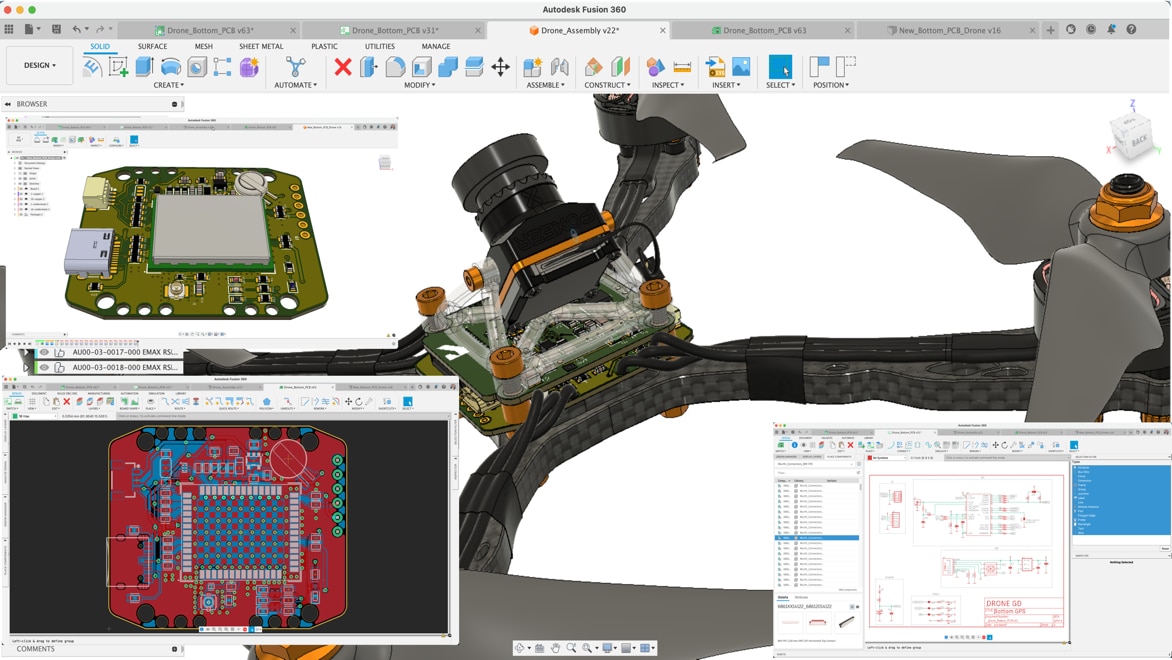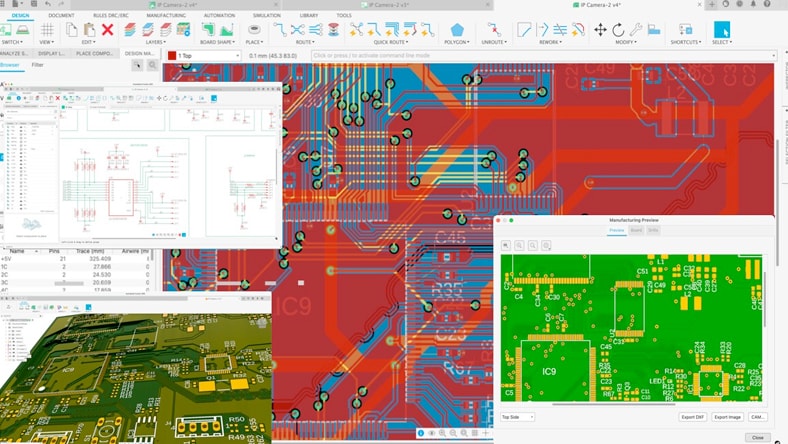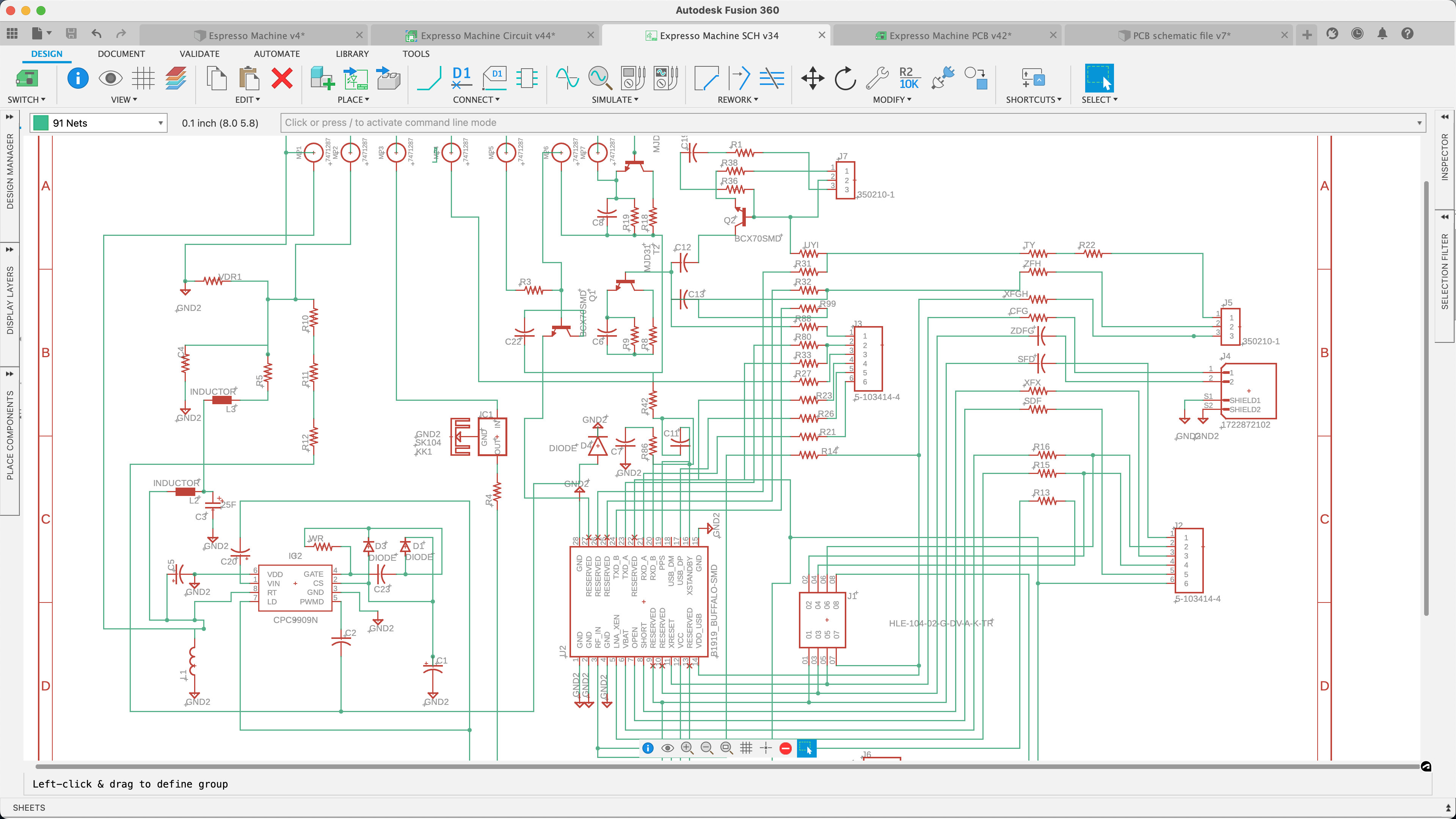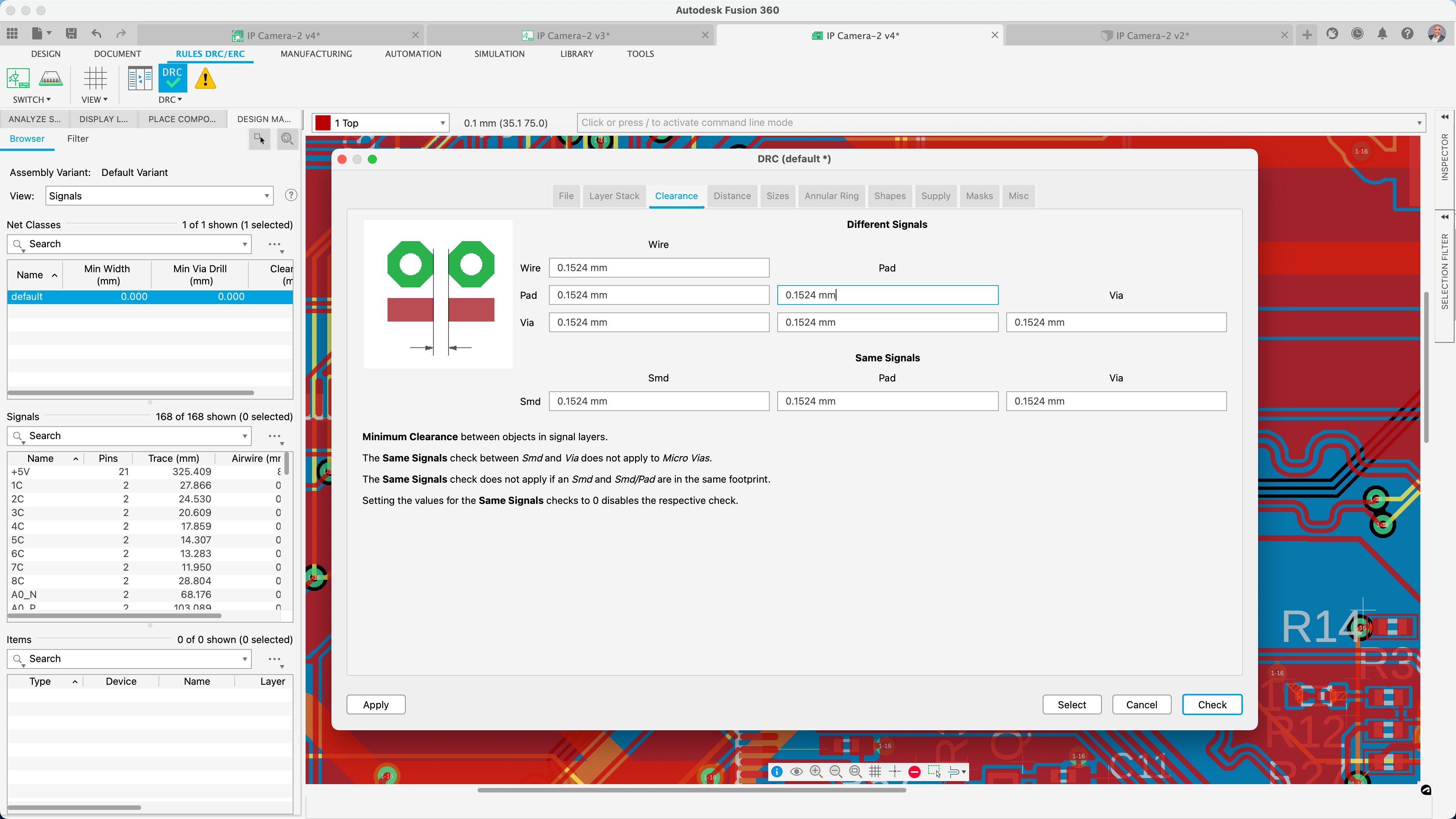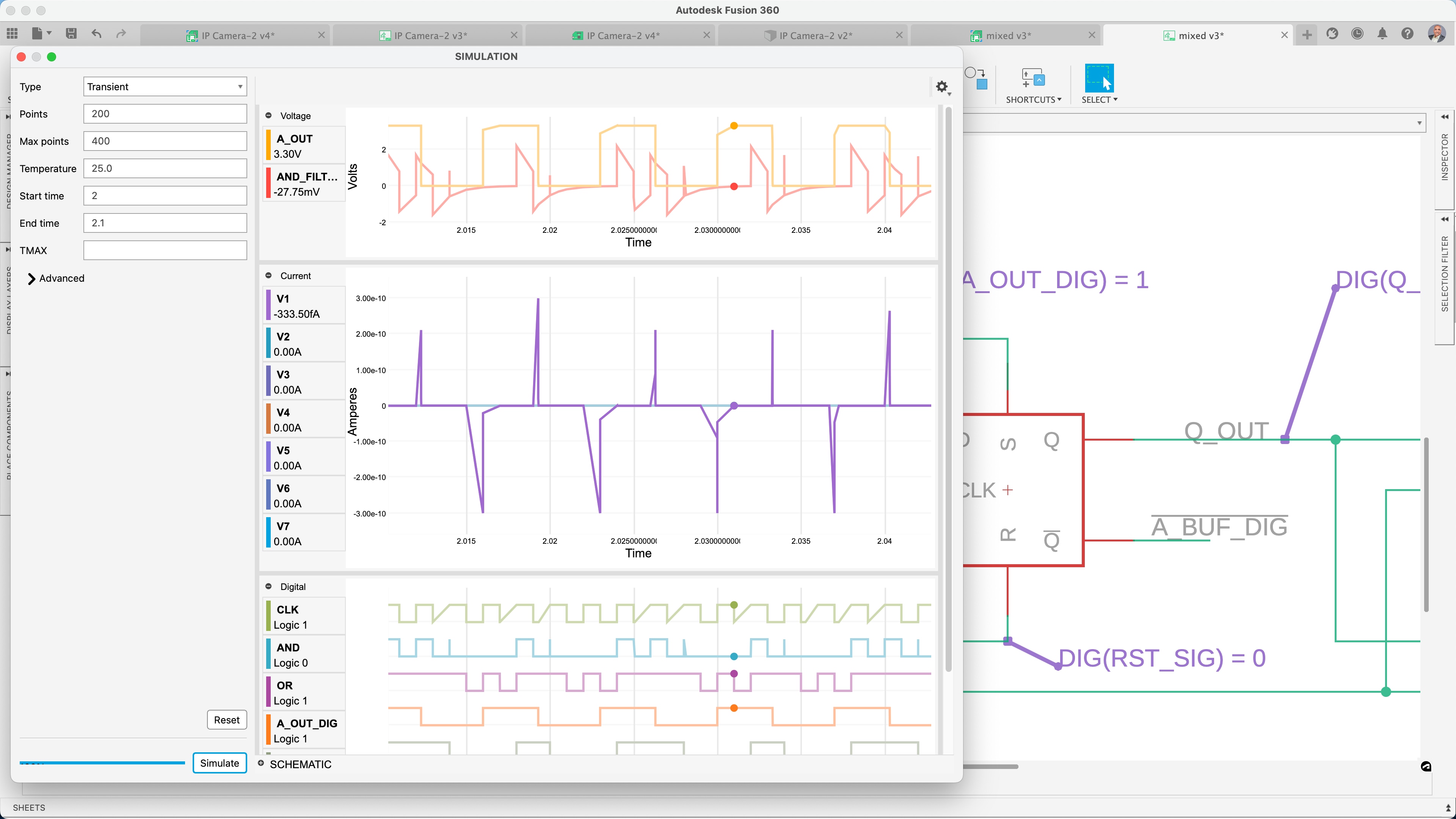& Construction

Integrated BIM tools, including Revit, AutoCAD, and Civil 3D
& Manufacturing

Professional CAD/CAM tools built on Inventor and AutoCAD
Electronic design is developing and integrating electronic components to achieve desired functionality or performance in a product or system. This includes research, creating schematics, designing printed circuit boards (PCBs), and building prototypes to test and optimize the design.
Electronic design is a critical component of the product development process, and it requires a combination of technical knowledge, creativity, and problem-solving skills. Electronics design is crucial in various industries, including consumer electronics, automotive, aerospace, telecommunications, medical devices, and more. It requires expertise in circuit theory, electronic components, signal processing, and electromagnetic compatibility (EMC). As well as considerations for power consumption, size, and cost constraints to make sure that the final product meets the necessary standards and regulations. Learn more about the basics of electronics in this Electronics for Beginners Guide.
Electronic design automation (EDA) is a software category for designing electronic systems, including circuits and printed circuit boards. Using electronics computer aided design (ECAD) solutions, engineers can automate various stages of the design process and have access to create, analyze, simulate, and verify electronic circuit systems.
EDA software plays a crucial role in designing, analyzing, and optimizing electronic systems. It enhances productivity, improves design quality, facilitates collaboration, and ultimately contributes to developing innovative and efficient products in the electronics industry. By catching errors early and streamlining the design process, engineers can minimize costly rework, shorten time-to-market, and improve product reliability.
Electronic design automation and EDA software are critical for electronics design.
Electronic design automation tools streamline the design process by automating repetitive tasks, such as schematic capture, layout, and simulation. This automation frees up engineers' time, allowing them to focus on higher-level design decisions and innovation.
EDA tools offer advanced simulation and verification capabilities that enable engineers to thoroughly analyze designs before fabrication. By simulating the behavior of electronic circuits under various conditions, potential issues and errors can be identified and corrected early in the design phase.
By accelerating the design process and facilitating rapid iterations, companies can bring their products to market faster, gaining a competitive edge in rapidly evolving industries.
Understanding the specifications and functional requirements of the electronic system or device that needs to be designed.
A logical circuit diagram that represents the interconnections and required components of the electronic circuit.
Choosing electronic components based on their specifications, performance characteristics, availability, and cost.
Transferring the circuit diagram into a printed circuit board (PCB) layout. Involves arranging electronic components, traces, vias, and other elements on the board for proper functionality and electrical performance.
Conducting various tests to validate the design, including functional testing, electrical testing, and performance evaluation to assure component functionality.
Electronic design automation (EDA) tools export the necessary manufacturing files, including ODB++, Gerber files for PCB fabrication, bill of materials (BOM), and assembly instructions to streamline production and help manufacturing accuracy.
Autodesk Fusion combines electronics and mechanical design, simulation, collaboration, and machining connecting the entire product development process in one software solution.
Fusion electronics offers a unified approach to both ECAD and MCAD design workflows that puts these desperate design domains in one integrated environment. Your ECAD data is the exact same data set as your MCAD data eliminating the need for multiple file exchange formats including STEP, IGES, IDF, and more.
Learn more about how Fusion makes electronics to mechanical workflows easy with seamless ECAD/MCAD integration.
Truly integrated ECAD/MCAD software eliminates the need for separate software solutions. Your PCB data is your mechanical data.
Gain access to a comprehensive environment for schematic design, PCB layout, component placement, and routing.
The built-in design rule checking (DRC) and validation tools in Autodesk Fusion electronics make sure that designs meet industry standards and design constraints.
A single cloud solution allows for effective collaboration and that every stakeholder is part of the product development cycle. Design changes are automatically managed to enable you to revise your board shape, component placement update, or modified enclosure.
Bring your designs to life with automation. Use schematic design, PCB layout, and routing capabilities built into Fusion.
Save valuable design time with a complete set of schematic tools. Get access to thousands of components. Interconnect circuits and create custom attribute assignments.
The PCB editor lets you connect your ideas together in the shortest time possible. Even the layout of dense boards is possible with a complete set of PCB layout tools.
Stay true to your manufacturing requirements with customizable design rules.
Export the manufacturing files in ODB++ or Gerbers, drill files, and assembly files within a few clicks.
Use our Spice Simulator to map components and verify that the expected results are being met.
The significant amount of ready-to-use component assets in the libraries and the component calcultors will help you focus on the design.
The e-cooling analysis features in Fusion allow users to simulate and evaluate the thermal behavior of their designs.
Cloud-based product design software for manufacturing, 3D modeling, electronics, simulation, and data management
Optimize part design and performance with unlimited cloud solves for generative design, FEA, electronic cooling, injection molding, and more.
Learn how to use electronic design automation and modular design blocks to streamline the development process.
ECAD/MCAD integration is no longer an option in product design. See how Fusion can make complex electromechanical workflows easy without file conversion.
Learn the benefits of electronic design automation and how to leverage available technology as the demand for smart technology increases.
Learn why you should start using Fusion electronics and workflows that will speed up your design time.
Manage your design, not your tools. Enjoy the most unified and connected ECAD MCAD experience for your PCB with Fusion Electronics.
The Fusion Signal Integrity Extension, powered by Ansys, unlocks more PCB/electronics signal integrity tools and capabilities, allowing you to run electromagnetic analysis on critical signals within your PCB.
Autodesk Fusion electronics offers compatibility through common file formats, allowing you to exchange designs and collaborate with other Electronic design automation (EDA) software tools.
Yes, Fusion electronics provides tools and features that allow you to define and design your own custom electronic components and footprints to use in your PCB designs.
Yes, Fusion electronics allows you to test your designs to make sure they will survive real-world conditions. Simulate your products digitally, reducing the cost of prototyping by using fully validated solvers.
Yes, Fusion electronics includes built-in sharing and collaboration tools. These features make it easy to collaborate with team members, clients, and suppliers in real time. Thus, streamlining the design process and fostering a more efficient workflow.
Yes, Fusion offers Electronics Design Automation (EDA) capabilities. It provides a comprehensive set of tools for schematic design, circuit simulation, PCB layout, and collaboration, allowing engineers to seamlessly integrate electronics design within the Fusion ecosystem.
The electronic design automation features in Fusion include schematic capture, circuit simulation, PCB layout and routing, library management, design rule checking (DRC), and collaboration tools. These features enable engineers to design and validate electronic circuits and systems efficiently.
Yes, electronic design automation (EDA) is crucial in the design process, particularly for complex electronic systems. EDA software tools automate various aspects of the design workflow, including schematic capture, PCB layout, simulation, and verification. These tools significantly enhance productivity, improve accuracy, and reduce time-to-market for electronic products. Given the increasing complexity and demands of modern electronic systems, Electronic design automation plays an indispensable role in ensuring efficient and reliable designs.
EDA design, or Electronic Design Automation design, refers to the process of designing electronic systems or circuits using specialized software tools known as Electronic Design Automation (EDA) tools. These tools facilitate the creation, simulation, verification, and manufacturing preparation of electronic designs. EDA design encompasses various stages, including conceptualization, schematic capture, PCB layout, simulation, verification, and prototyping.
When choosing Electronic Design Automation (EDA) software, several factors should be considered:

